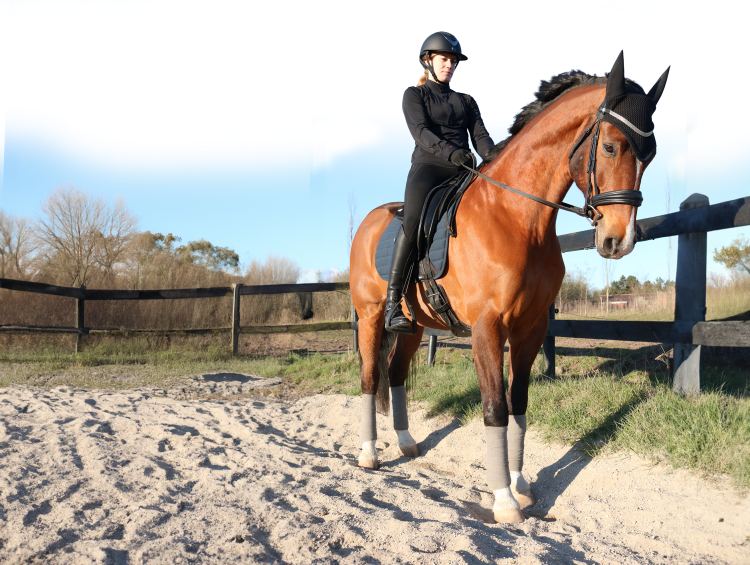Once you have mastered the halt, you have created a good foundation for the rest of your training
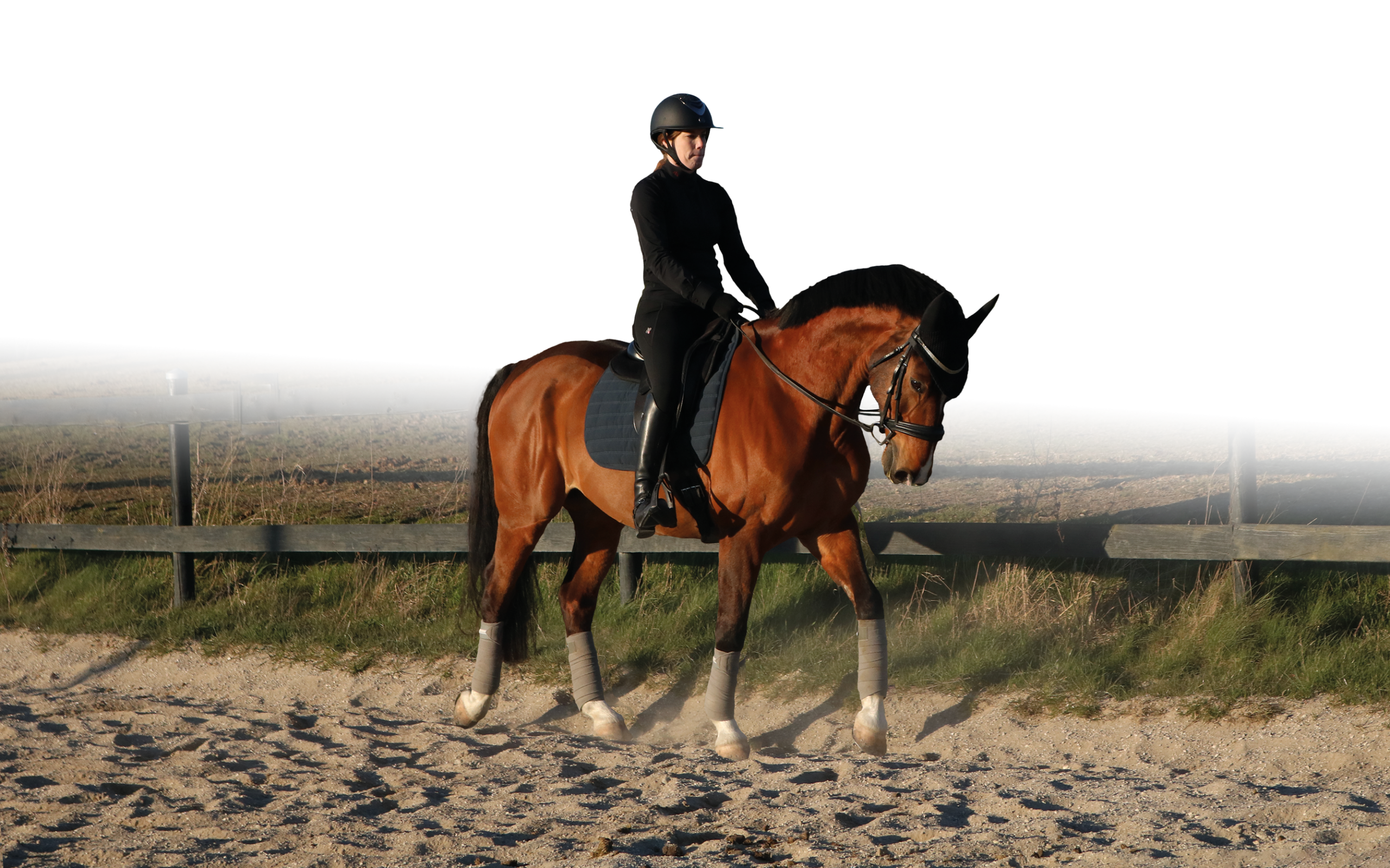
Common Challenges
Is your horse curling it's neck in?
If your horse is doing so and continuing to walk, when you ask for a halt signal, then continue to keep the pressure. If you let go, then the horse may have learned that the task is to curl in its neck and overbend to make the pressure go away. You should not worry about your horse overbending and keep the pressure till the horse stops. Preferably, practise this from the ground.
Is your horse turning in the halt?
If your horse has a poor balance, you may find that it spins around when you ask it to perform a halt.
When riding into the halt, try to keep your horse's head pointed in the same direction at all times. It's harder for your horse to turn, when its head is kept straight. This way, you can avoid the front- or the hind-end falling to either side.
You also need to be very aware of your hands. You may have one hand stronger than the other and it may be the reason your horse is unbalanced and doesn't stop straight. Therefore, observe whether your horse always goes to the right or left when you give the signal. Adjust the pressure in your hands so that your horse's head always remains straight in front of you.
Does your horse walk on as soon as you let go of the reins?
There can be two common reasons why a horse walks forward once the reins are released. Either it thinks it has to go forward or it has poor balance and therefore stumbles forward.
The solution to both challenges is to repeat the signal for halt until the horse stops walking. Practise from the ground. If your horse has a lot of difficulty with the halt, wait for a bit before moving on. The horse should feel that it is comfortable to stand still and that it can keep its balance whilst standing.
You may want to count to 5 or 10 before walking on again. If your horse is very impatient, it is important that you are the one giving the signal to walk forward again. Over time, it will become easier for the horse to stand still, breathe and relax.
Please take note, that if your horse has a tendency to avoid your signals there might be a health aspect involved. It is recommended to have your horse checked by professionals.
About the author
Christina Holmbæck has been teaching all types of horse riders for more than 16 years. Her training method is called ”riding-art with ease” and is based on biomechanics of the horse and modern learning psychology. The goal is to have as light aids as possible, and to have a balanced horse.
The halt: One of the most important
keys for further education
The halt is one of the most important keys to the rest of your training. In order to teach your horse the correct way, you need to train your horse at the level it is ready for.
Continuing to squeeze with your knees after your horse has stopped
Keeping the pressure on the rein after your horse has stopped



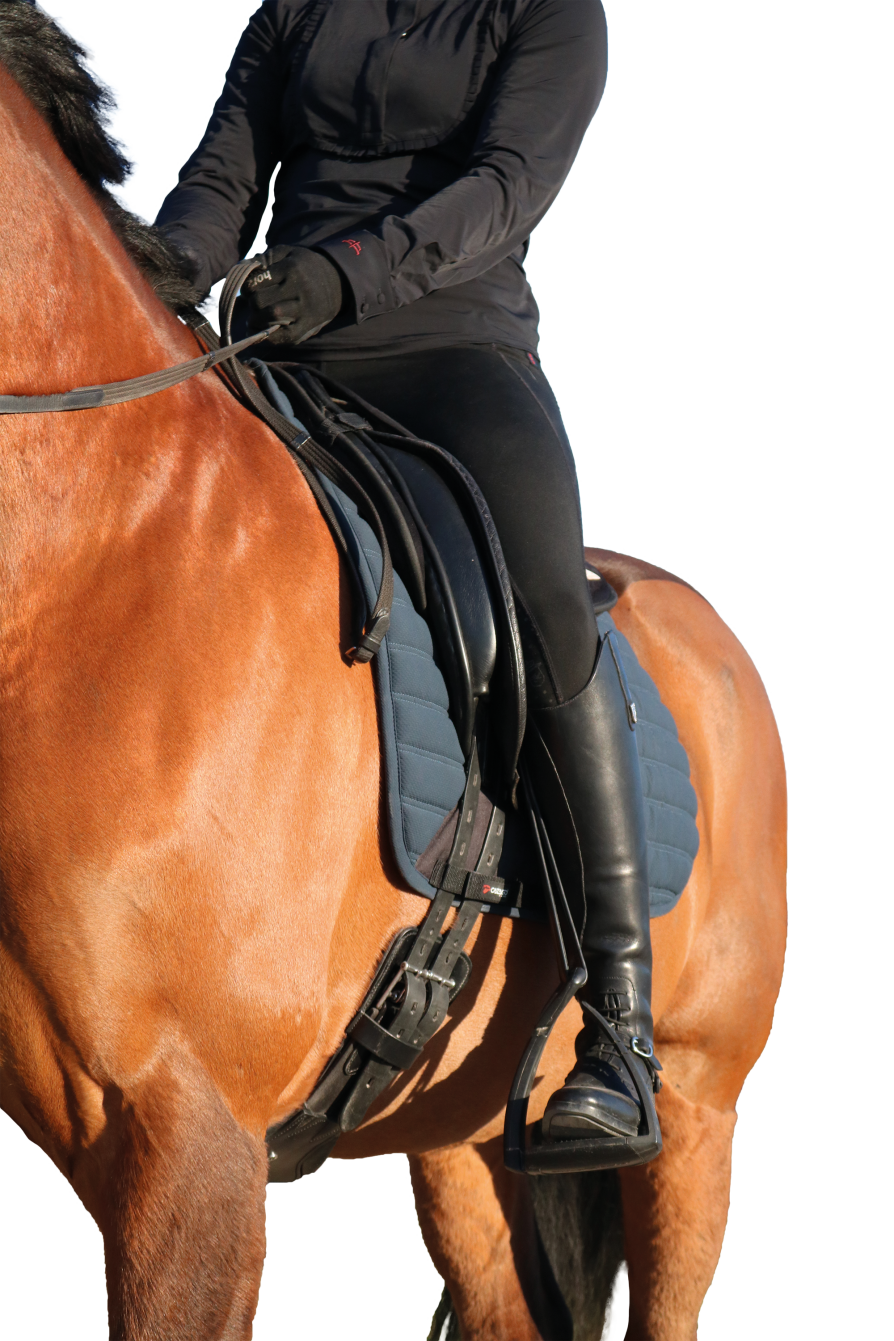
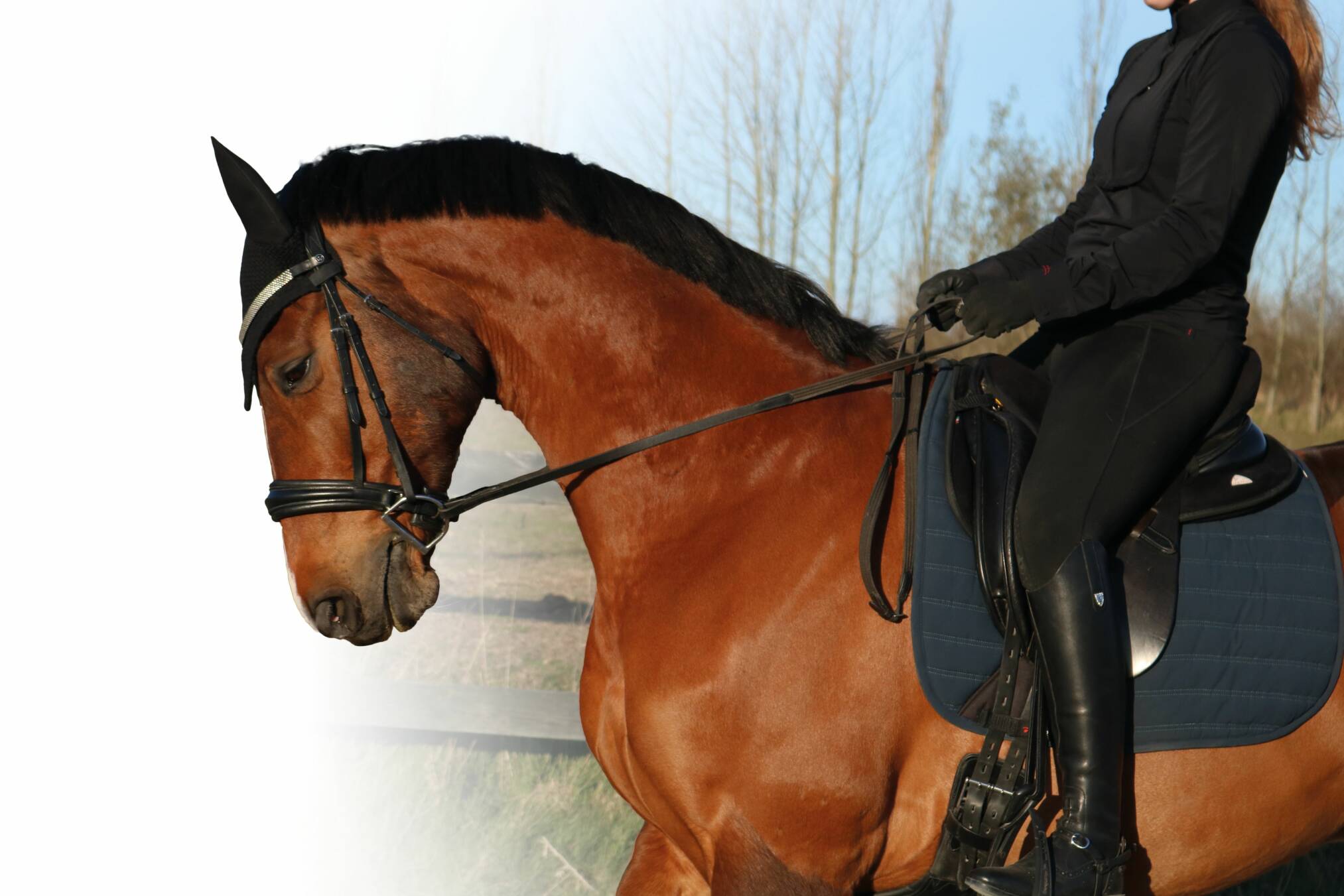
AVIOD THIS!
I f your aim for your horse is to learn to engage its hindquarters, lift its back, and be collected with light aids, then you should avoid doing the following:
Leaning back too much
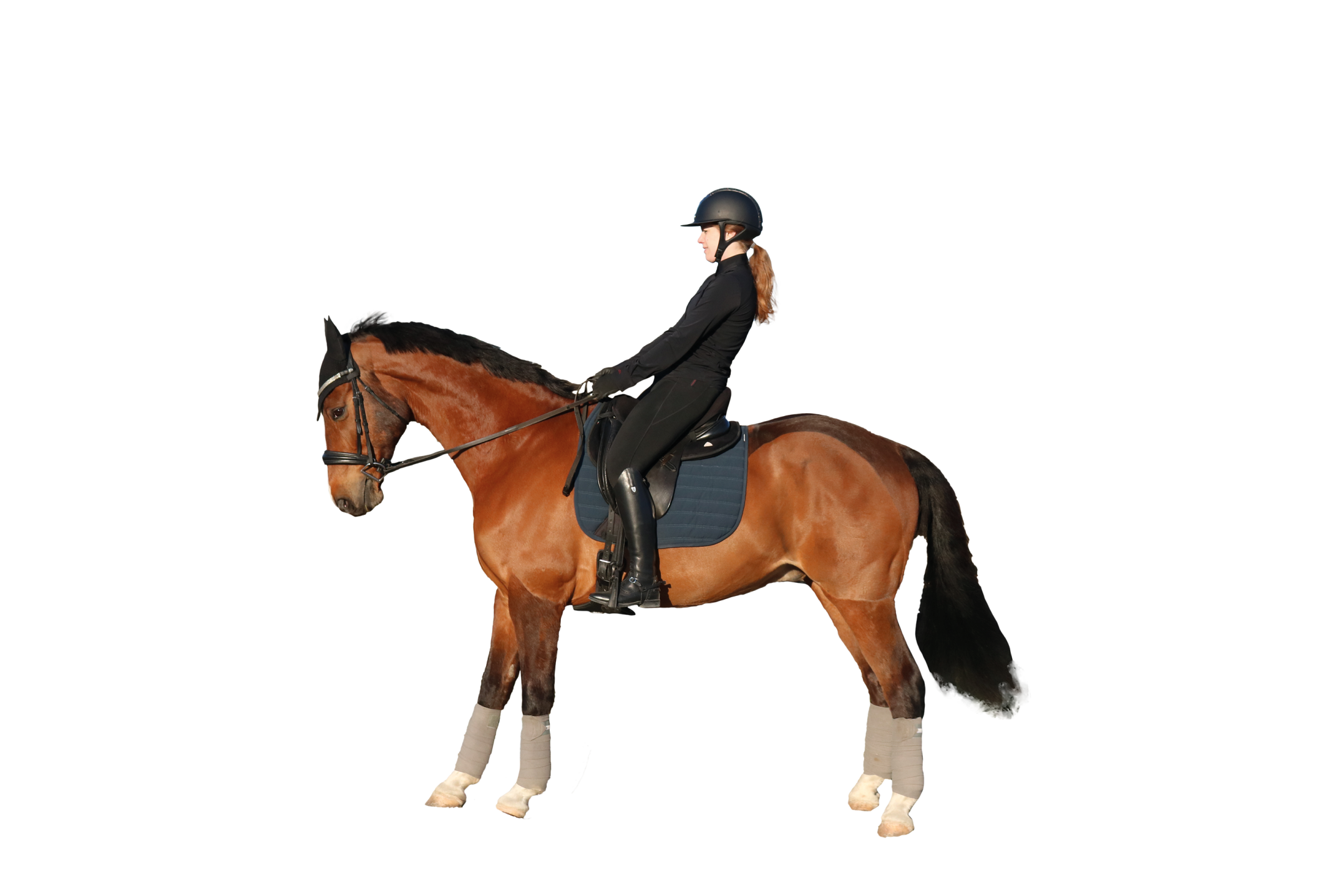
B ut my horse halts straight away when I do those three things,” you might think. Yes, but it is compromising the training of the horse. Because when you squeeze with your knees, it creates tension in the rider’s seat, which makes the horse tense in its back. And when you lean backwards in the saddle, you push down on the horse’s lumbar region, which is not optimal for the horse.
In other words, the rider’s position can prevent the horse from tilting its pelvis and lifting its back. To maintain balance, the horse needs to lift its neck and head, which the rider will hinder by keeping pressure on the reins.
The halt is a technically difficult exercise
The halt requires coordination and balance from both the horse and the rider. It usually takes a long time before the horse can perform the halt correctly. When teaching the halt, I typically divide the training into two levels.
Count to 3
It is clearer for your horse to understand what you want from it, when you are very specific in your signals. When you give the signal for halt, imagine that you first brake one fronthoof (1) and then the other frontfoot (2), and as soon as your horse stands still, remember to release the pressure on both reins (3).
If your horse finds it difficult to stop
If your horse does not stop from light pressure, avoid pulling harder. This will usually make the horse pull against the pressure, instead of stopping.
Try instead to raise one hand higher and still maintain an even pressure on both reins. This will make your horse’s neck rotate slightly, preventing it from pulling against the pressure with its entire body. And it is much gentler than pulling harder on the jaw.
If your horse still is not easy to stop, I recommend that you train the halt from the ground.
Practising the halt from the ground
When you want to do a halt from the ground, you can start by leading the horse on the edge of the arena. This will make it easier for your horse to understand the signal, as it can not move away from you.
Gently pull on both reins whilst following your horse. If you stop before your horse, you will end up pulling on the bit. Therefore, stop only after your horse has stopped. Remember to acknowledge your horse’s reaction when it stops: release the reins, take a breath, relax your body, and stroke its neck.
You will make it even easier for your horse, by practicing the halt in the same location. Once you can see that your horse understands the signal, you can challenge it by practicing the halt in different locations without the support of a barrier or fence.
If your horse does not respond to a light pressure, you can also lift one hand higher while on the ground. Still maintain an equal pressure on both reins and release as soon as your horse stops.
Experiment with the pressure
Experiment with the pressure from your hands. If you hold too lightly or press too hard, your horse will continue to walk. Find the pressure that your horse responds best to. And keep your goal in mind: for the horse to stop from an ultra-light touch.
CHECKLIST:
Stay upright in your upper body, so your weight is on your inner thighs, instead of down on the horse’s lumbar region.
Relax your knees, hips, and feet (especially with stirrups), to avoid making your horse’s back tense.
Have a light contact on both reins. Possibly shorten your reins so you do not end up pulling your elbows back. That will result in hard hands against the horses’ mouth.
Remember to breathe.
Level 1 - Understanding the signal
At this level, the focus is, that the horse is understanding the stop signal given by the rider. At the same time the horse is as relaxed as possible within its body. At this stage a “belly landing” into the halt is accepted. It is okay for the horse to stop heavily on the forehand and lift its neck and head to maintain balance, as long as the horse understood the task.
Ideally, the horse’s weight should be on the hindquarters into the halt. However, if the horse is tense in its topline and you drive it into the halt, this will increase the tension and push it further onto the forehand. Therefore, the horse must first learn to stop and relax from a light touch.
Level 2 - Biomechanical learning technique
At this level, the focus is on the biomechanics of the horse, specifically its posture into and during the halt. The goal is for the horse to be able to settle and be relaxed into the halt, stretch its entire topline, and seek forward and down into the reins. The prerequisites for the horse to be ready for this level are, that it is relaxed, able to perform shoulder-in and half pass and can collect without tensing its back or shortening the neck.
By: Christina Holmbæck Photos: Camilla Funch Jandrup
It is much easier to get the horse to halt with a hollow back than to have it collected, engaging from the hind and stretching through the topline. But you should not fall for the temptation of choosing the easy solution here, as in the long run, you will lack the quality needed to further educate your horse.
- A guide for riders at all levels
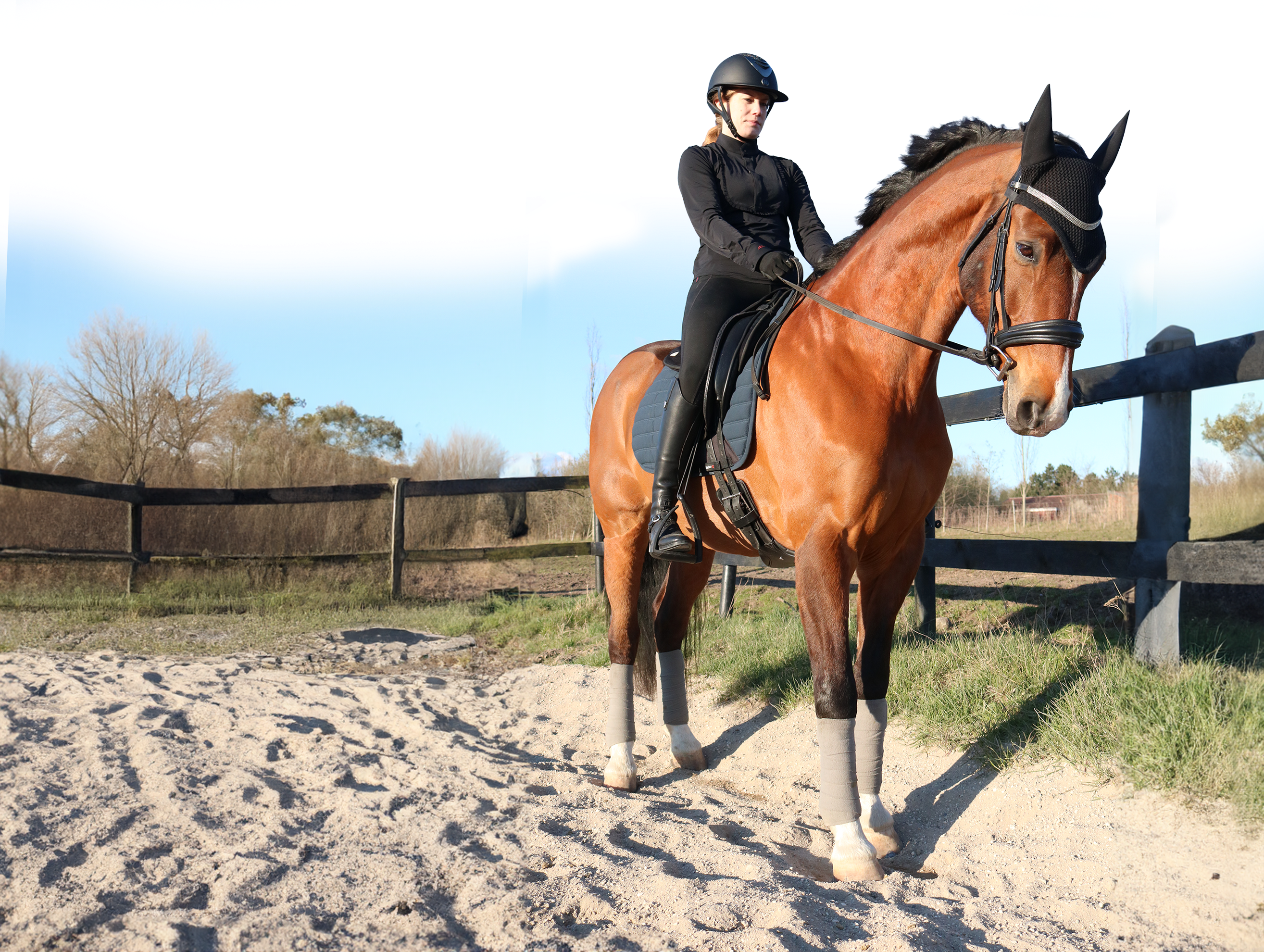
AVIOD THIS!
I f your aim for your horse is to learn to engage its hindquarters, lift its back, and be collected with light aids, then you should avoid doing the following:
Is your horse curling it's neck in?
If your horse is doing so and continuing to walk, when you ask for a halt signal, then continue to keep the pressure. If you let go, then the horse may have learned that the task is to curl in its neck and overbend to make the pressure go away. You should not worry about your horse overbending and keep the pressure till the horse stops. Preferably, practise this from the ground.
Is your horse turning in the halt?
If your horse has a poor balance, you may find that it spins around when you ask it to perform a halt.
When riding into the halt, try to keep your horse's head pointed in the same direction at all times. It's harder for your horse to turn, when its head is kept straight. This way, you can avoid the front- or the hind-end falling to either side.
You also need to be very aware of your hands. You may have one hand stronger than the other and it may be the reason your horse is unbalanced and doesn't stop straight. Therefore, observe whether your horse always goes to the right or left when you give the signal. Adjust the pressure in your hands so that your horse's head always remains straight in front of you.
Does your horse walk on as soon as you let go of the reins?
There can be two common reasons why a horse walks forward once the reins are released. Either it thinks it has to go forward or it has poor balance and therefore stumbles forward.
The solution to both challenges is to repeat the signal for halt until the horse stops walking. Practise from the ground. If your horse has a lot of difficulty with the halt, wait for a bit before moving on. The horse should feel that it is comfortable to stand still and that it can keep its balance whilst standing.
You may want to count to 5 or 10 before walking on again. If your horse is very impatient, it is important that you are the one giving the signal to walk forward again. Over time, it will become easier for the horse to stand still, breathe and relax.
Please take note, that if your horse has a tendency to avoid your signals there might be a health aspect involved. It is recommended to have your horse checked by professionals.
Common Challenges

Once you have mastered the halt, you have created a good foundation for the rest of your training
About the author
Christina Holmbæck has been teaching all types of horse riders for more than 16 years. Her training method is called ”riding-art with ease” and is based on biomechanics of the horse and modern learning psychology. The goal is to have as light aids as possible, and to have a balanced horse.
The halt: One of the most important
keys for further education
The halt is one of the most important keys to the rest of your training. In order to teach your horse the correct way, you need to train your horse at the level it is ready for.
Keeping the pressure on the rein after your horse has stopped
Continuing to squeeze with your knees after your horse has stopped


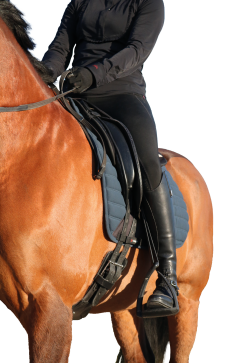


Leaning back too much

B ut my horse halts straight away when I do those three things,” you might think. Yes, but it is compromising the training of the horse. Because when you squeeze with your knees, it creates tension in the rider’s seat, which makes the horse tense in its back. And when you lean backwards in the saddle, you push down on the horse’s lumbar region, which is not optimal for the horse.
In other words, the rider’s position can prevent the horse from tilting its pelvis and lifting its back. To maintain balance, the horse needs to lift its neck and head, which the rider will hinder by keeping pressure on the reins.
The halt is a technically difficult exercise
The halt requires coordination and balance from both the horse and the rider. It usually takes a long time before the horse can perform the halt correctly. When teaching the halt, I typically divide the training into two levels.
Count to 3
It is clearer for your horse to understand what you want from it, when you are very specific in your signals. When you give the signal for halt, imagine that you first brake one fronthoof (1) and then the other frontfoot (2), and as soon as your horse stands still, remember to release the pressure on both reins (3).
If your horse finds it difficult to stop
If your horse does not stop from light pressure, avoid pulling harder. This will usually make the horse pull against the pressure, instead of stopping.
Try instead to raise one hand higher and still maintain an even pressure on both reins. This will make your horse’s neck rotate slightly, preventing it from pulling against the pressure with its entire body. And it is much gentler than pulling harder on the jaw.
If your horse still is not easy to stop, I recommend that you train the halt from the ground.
Practising the halt from the ground
When you want to do a halt from the ground, you can start by leading the horse on the edge of the arena. This will make it easier for your horse to understand the signal, as it can not move away from you.
Gently pull on both reins whilst following your horse. If you stop before your horse, you will end up pulling on the bit. Therefore, stop only after your horse has stopped. Remember to acknowledge your horse’s reaction when it stops: release the reins, take a breath, relax your body, and stroke its neck.
You will make it even easier for your horse, by practicing the halt in the same location. Once you can see that your horse understands the signal, you can challenge it by practicing the halt in different locations without the support of a barrier or fence.
If your horse does not respond to a light pressure, you can also lift one hand higher while on the ground. Still maintain an equal pressure on both reins and release as soon as your horse stops.
Experiment with the pressure
Experiment with the pressure from your hands. If you hold too lightly or press too hard, your horse will continue to walk. Find the pressure that your horse responds best to. And keep your goal in mind: for the horse to stop from an ultra-light touch.
CHECKLIST:
Stay upright in your upper body, so your weight is on your inner thighs, instead of down on the horse’s lumbar region.
Relax your knees, hips, and feet (especially with stirrups), to avoid making your horse’s back tense.
Have a light contact on both reins. Possibly shorten your reins so you do not end up pulling your elbows back. That will result in hard hands against the horses’ mouth.
Remember to breathe.
Level 1 - Understanding the signal
At this level, the focus is, that the horse is understanding the stop signal given by the rider. At the same time the horse is as relaxed as possible within its body. At this stage a “belly landing” into the halt is accepted. It is okay for the horse to stop heavily on the forehand and lift its neck and head to maintain balance, as long as the horse understood the task.
Ideally, the horse’s weight should be on the hindquarters into the halt. However, if the horse is tense in its topline and you drive it into the halt, this will increase the tension and push it further onto the forehand. Therefore, the horse must first learn to stop and relax from a light touch.
Level 2 - Biomechanical learning technique
At this level, the focus is on the biomechanics of the horse, specifically its posture into and during the halt. The goal is for the horse to be able to settle and be relaxed into the halt, stretch its entire topline, and seek forward and down into the reins. The prerequisites for the horse to be ready for this level are, that it is relaxed, able to perform shoulder-in and half pass and can collect without tensing its back or shortening the neck.
By: Christina Holmbæck Photos: Camilla Funch Jandrup
It is much easier to get the horse to halt with a hollow back than to have it collected, engaging from the hind and stretching through the topline. But you should not fall for the temptation of choosing the easy solution here, as in the long run, you will lack the quality needed to further educate your horse.
- A guide for riders at all levels
